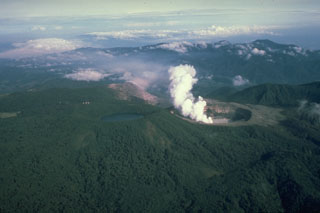Report on Poas (Costa Rica) — 12 February-18 February 2025
Smithsonian Institution / US Geological Survey
Weekly Volcanic Activity Report, 12 February-18 February 2025
Managing Editor: Sally Sennert.
Please cite this report as:
Global Volcanism Program, 2025. Report on Poas (Costa Rica) (Sennert, S, ed.). Weekly Volcanic Activity Report, 12 February-18 February 2025. Smithsonian Institution and US Geological Survey.
Poas
Costa Rica
10.2°N, 84.233°W; summit elev. 2697 m
All times are local (unless otherwise noted)
The Observatorio Vulcanológico y Sismológico de Costa Rica-Universidad Nacional (OVSICORI-UNA) reported that eruptive activity at Poás was recorded during 11-18 February. The lake water level had dropped about 0.3 m in a week and convection cells over underwater fumarolic vents persisted; convecting water over Boca C vent was noted during 11-12 February. Sulfur dioxide gas flux significantly increased to 445 +/- 504 tons per day (t/d) on 13 February and was higher than the average of 267 +/- 97 t/d detected during the previous week. Frequent (every minute) phreatic explosions at Boca C were recorded during 15-17 February based on seismic and acoustic data. Material was ejected above the lake’s surface as high as 200 m. Sulfur dioxide emissions had decreased by 16 February. The frequency of phreatic explosions decreased during 17-18 February, though events were characterized as both intense and low magnitude, with ejected material rising less than 200 m.
Geological Summary. The broad vegetated edifice of Poás, one of the most active volcanoes of Costa Rica, contains three craters along a N-S line. The frequently visited multi-hued summit crater lakes of the basaltic-to-dacitic volcano are easily accessible by vehicle from the nearby capital city of San José. A N-S-trending fissure cutting the complex stratovolcano extends to the lower N flank, where it has produced the Congo stratovolcano and several lake-filled maars. The southernmost of the two summit crater lakes, Botos, last erupted about 7,500 years ago. The more prominent geothermally heated northern lake, Laguna Caliente, is one of the world's most acidic natural lakes, with a pH of near zero. It has been the site of frequent phreatic and phreatomagmatic eruptions since an eruption was reported in 1828. Eruptions often include geyser-like ejections of crater-lake water.
Source: Observatorio Vulcanologico y Sismologico de Costa Rica-Universidad Nacional (OVSICORI-UNA)

